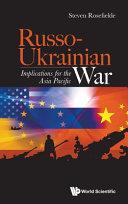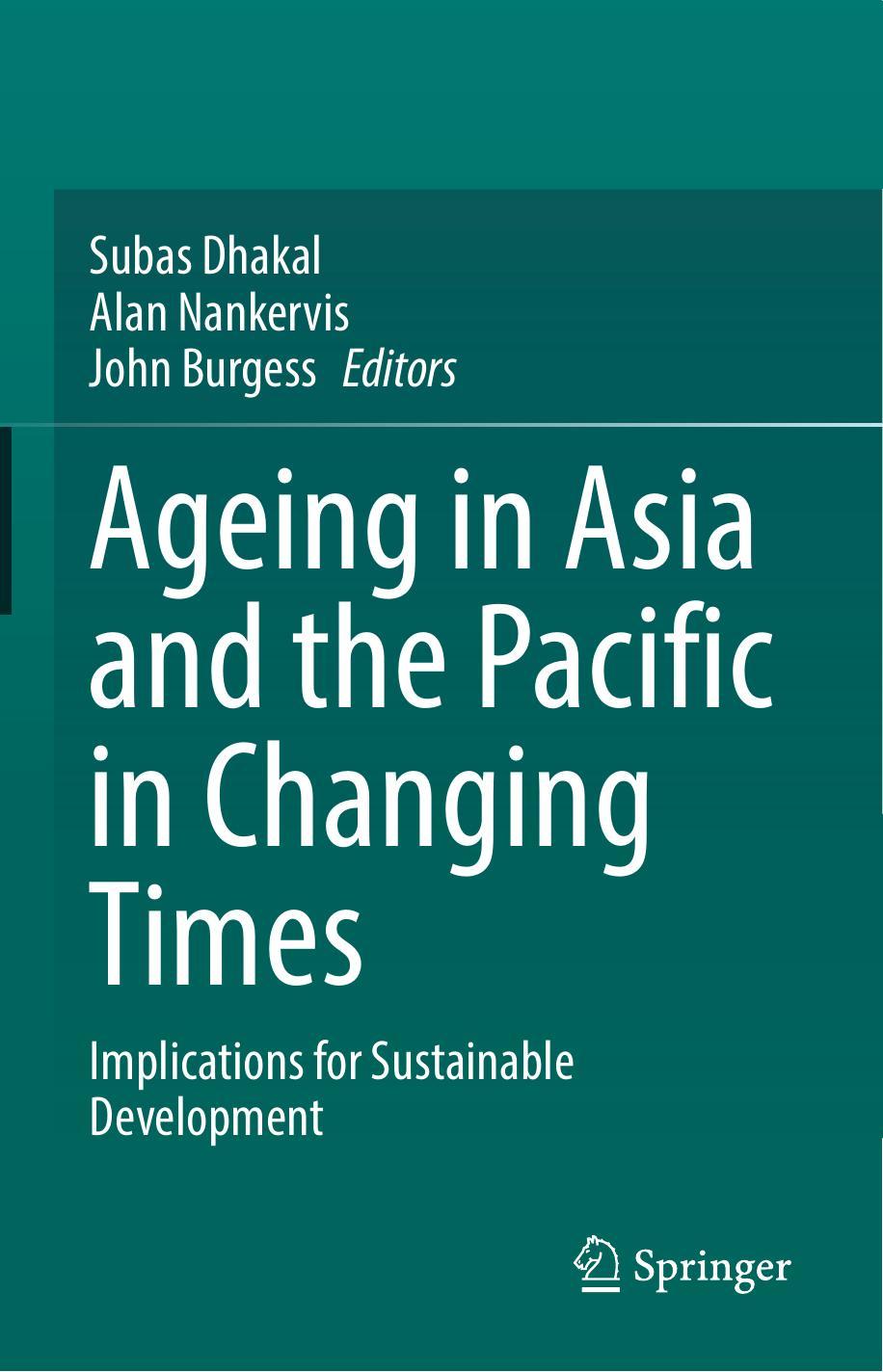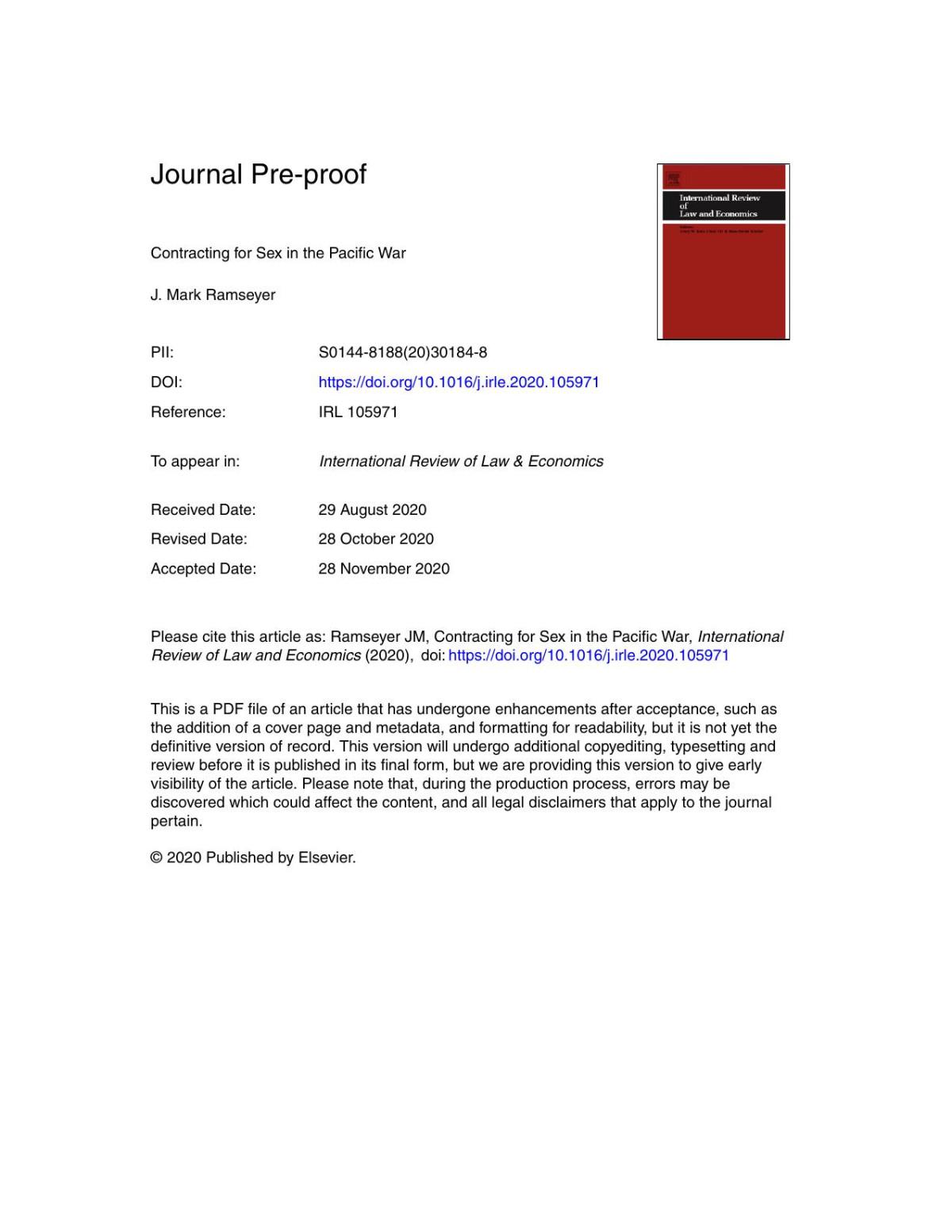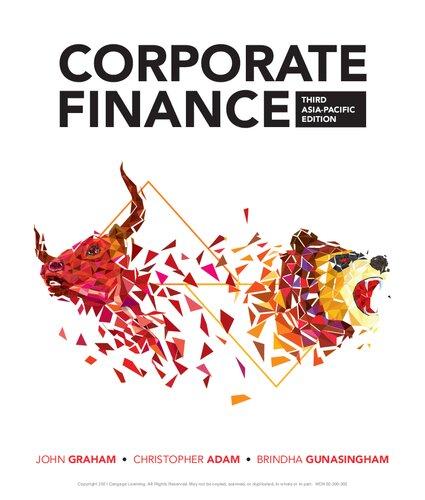RussoUkrainian War
Implications for the Asia Pacific
Steven Rosefielde
University of North Carolina, Chapel Hill, USA
Published by
World Scientific Publishing Co. Pte. Ltd.
5 Toh Tuck Link, Singapore 596224
USA office: 27 Warren Street, Suite 401-402, Hackensack, NJ 07601
UK office: 57 Shelton Street, Covent Garden, London WC2H 9HE
Library of Congress Cataloging-in-Publication Data
Names: Rosefielde, Steven, author.
Title: Russo-Ukrainian war : implications for the Asia Pacific / Steven Rosefielde, University of North Carolina, Chapel Hill, USA.
Description: New Jersey : World Scientific, 2024. | Includes bibliographical references and index.
Identifiers: LCCN 2023015013 | ISBN 9789811274879 (hardcover) | ISBN 9789811274886 (ebook) | ISBN 9789811274893 (ebook other)
Subjects: LCSH: Pacific Area--Strategic aspects. | United States--Foreign relations-Russia (Federation) | United States--Foreign relations--China. | China--Foreign relations--United States | Russia (Federation)--Foreign relations--United States | Ukraine--History--Russian Invasion, 2022– | Proxy war--United States.
Classification: LCC E183.8.R9 R64 2024 | DDC 327.73047--dc23/eng/20230404
LC record available at https://lccn.loc.gov/2023015013
British Library Cataloguing-in-Publication Data
A catalogue record for this book is available from the British Library.
Copyright © 2024 by World Scientific Publishing Co. Pte. Ltd.
All rights reserved. This book, or parts thereof, may not be reproduced in any form or by any means, electronic or mechanical, including photocopying, recording or any information storage and retrieval system now known or to be invented, without written permission from the publisher.
For photocopying of material in this volume, please pay a copying fee through the Copyright Clearance Center, Inc., 222 Rosewood Drive, Danvers, MA 01923, USA. In this case permission to photocopy is not required from the publisher.
For any available supplementary material, please visit https://www.worldscientific.com/worldscibooks/10.1142/13370#t=suppl
Desk Editors: Aanand Jayaraman/Yulin Jiang
Typeset by Stallion Press
Email: enquiries@stallionpress.com
Printed in Singapore
Preface
Winston Churchill famously declared that:
I cannot forecast to you the action of Russia. It is a riddle wrapped in a mystery inside an enigma; but perhaps there is a key. That key is Russian national interest. It cannot be in accordance with the interest of the safety of Russia that Germany should plant itself upon the shores of the Black Sea, or that it should overrun the Balkan States and subjugate the Slavonic peoples of south eastern Europe. That would be contrary to the historic life-interests of Russia.
—Winston Churchill, The Russian Enigma, Broadcast, October 1, 1939. http://www.churchill-society-london.org.uk/RusnEnig.html.
Eighty years ago, Winston Churchill surmised that even though Russia was a riddle wrapped in a mystery inside an enigma, there was a key: Russian national interest. He divined that the Soviet Kremlin was guided more by Russian patriotism in national security affairs than communism, and deduced that Moscow would do whatever it could to prevent a rival power from planting itself upon the shores of the Black Sea, overrunning the Balkan States, and subjugating the peoples of southeast Europe. Churchill was right about the durability of the Kremlin’s mindset. His judgment still holds. Whatever Vladimir Putin’s international ambitions may be, he is apt to place great stock in maintaining Russia’s national security.
Hitler admitted that he got Soviet Russia wrong in June 22, 1941. He underestimated the Kremlin’s arsenal, its military industrial strength, its
vi
Russo-Ukrainian War: Implications for the Asia Pacific war-fighting capability, and tenacity (Bernd, 1993; Steury, 1998, 2008; Murphy, 2006).1 So did American and British intelligence (Bergson, 1961, 1963; Samuelson, 1996; Kahn, 2012, 2017).
American policymakers made the same mistake in the wake of the Soviet Union’s demise. Washington interpreted communism’s defeat as a mandate to integrate and subordinate the Kremlin in America’s global order under the banner of Partner for Peace. The White House knew that Moscow was a nuclear superpower and was capable of quickly rearming its conventional forces as Stalin had during the 1930s (Rosefielde, 2005). It knew the Kremlin might eventually balk, but forged ahead without requisite confidence-building measures, risking Putin’s annexation of Crimea and the Russo-Crimean war (Beebe, 2021; Sachs, 2022).2
Crimea’s annexation and the Russo-Ukrainian War were avertable had Washington managed its relations with the Kremlin more wisely (Bergson, 1976).3 It should have been clear to Foggy Bottom that Washington could not micro-control Russia from afar and superpowers must find ways to avoid nation-threatening armed conflict.
Russo-Ukrainian War: Implications of the Asia-Pacific updates the backstory to the Russo-Ukrainian War, spotlighting where the RussoAmerican Partnership for Peace derailed, culminating in the second wave of the Cold War rather than assessing the balance of legal and moral rights and wrongs.4 It investigates obstacles impeding the prompt restoration of Peaceful Coexistence, Cold War, and Partnership for Peace without dwelling on military details, and probes the ramifications of the RussoAmerican Cold War for the Asia Pacific. The analysis builds on themes previously explored in a series of prior publications.
Endnotes
1 (Steury, 2008). “Yet, there can be no doubt that Murphy is correct both in detail and in the sum and substance of his argument: Stalin was well-served by his intelligence departments. The responsibility for ignoring that intelligence was his and his alone.”
“In closing, it is worth noting that there was another failure of judgment in BARBAROSSA, that of Adolf Hitler. Hitler, like Stalin, was a victim of his own preconceptions, but, in contrast to Stalin, he was ill-served by his intelligence services. Suffering from what the Japanese, from bitter experience, would call ‘victory disease,’ the Germans overestimated their own capabilities, even as they underestimated the Soviet capacity to resist. In July 1942, one year after the start
Preface vii
of the campaign, Hitler admitted as much to Marshal Carl Gustav Mannerheim, the Finnish military leader, on a visit to Helsinki — Finland then being a cobelligerent with Germany in its war with the Soviet Union. ‘We did not ourselves understand — just how strong this state [the USSR] was armed,’ Hitler told him, ‘If somebody had told me a nation could start with 35,000 tanks, then I’d have said, ‘You are crazy!’ … [Yet] … We have destroyed — right now — more than 34,000 tanks.… It was unbelievable.… I had no idea of it. If I had an idea — then it would have been more difficult for me, but I would have taken the decision to invade anyhow.…’”
2 Sachs’s cast of villains includes Donald Kagan, Norman Podhoretz, Irving Kristol, Paul Wolfowitz, Robert Kagan (son of Donald), Frederick Kagan (son of Donald), Victoria Nuland (wife of Robert), Elliott Cohen, Elliott Abrams, and Kimberley Allen Kagan (wife of Frederick).
3 Many people assume that the systems they prefer on intuitive, sentimental, aesthetic, and ethical grounds are objectively superior unaware that the facts needed to validate their judgments are mostly figments of, their imagination. The belief, duty, and willfulness of some do not negate the counter-views of others. Utility, belief, duty, and willfulness all count in assessing social welfare. Bergson argued that critical discourse offers a useful tool for finding common ground and perhaps consensus. Most analysts ignore his advice.
4 People tend to take strong stands on the Russo-Ukraine war based on intuitions about the motivations of key actors and feelings about justice. Intuitions are debatable, but conflicting perceptions are difficult to resolve.
References
Beebe, George. (2021). The Russia Trap: How Our Shadow War with Russia Could Spiral into Nuclear Catastrophe. New York: Tantor and Blackstone Publishing.
Bergson, Abram. (1961). The Real National Income of Soviet Russia since 1928. Cambridge, MA: Harvard University Press.
Bergson, Abram. (1963). National Income. In Bergson and Simon Kuznets (coeditors), Economic Trends in the Soviet Union. Cambridge, MA: Harvard University Press.
Bergson, Abram. (1976). Social Choice and Welfare Economics under Representative Government. Journal of Public Economics, Vol. 6, No. 3: 171–190.
Bernd Wegner, Bernd. (1993). Hitlers Besuch in Finnland 1942 (Dokumentation), Vierteljahrshefte für Zeitgeschichte, Vol. 43, No. 1: 131–132.
viii Russo-Ukrainian War: Implications for the Asia Pacific
Kahn, Martin. (2012). Russia will Assuredly Be Defeated: Anglo-American Government Assessments of Soviet War Potential before Operation Barbarossa. The Journal of Slavic Military Studies, Vol. 25, No. 2: 220–240.
Kahn, Martin. (2017). The Western Allies and Soviet Potential in World War II: Economy, Society and Military Power. London: Routledge.
Murphy, David. (2006). What Stalin Knew: The Enigma of Barbarossa. New Haven, CT: Yale University Press.
Rosefielde, Steven. (2005). Russia in the 21st Century: The Prodigal Superpower. Cambridge: Cambridge University Press.
Sachs, Jeffrey. (2022). Ukraine Is the Latest Neocon Disaster. Common Dreams. https://www.commondreams.org/views/2022/06/28/ukraine-latest-neocondisaster.
Samuelson, Lennart. (1996). Soviet Defence Industry Planning: Tukhachevskii and Military-Industrial Mobilisation, 1926–1937. Stockholm: Stockholm Institute of East European Economies.
Steury, Donald. (1998). Too Much Is Not Enough: Joseph Stalin, British Intelligence and Strategic Surprise in 1941, Studies in Intelligence, Vol. 42, No. 2.
Steury, Donald. (2008). What Stalin Knew: The Enigma of Barbarossa. CIA https://www.cia.gov/library/center-for-the-study-of-intelligence/csi-publications/csi-studies/studies/vol50no1/9_BK_What_Stalin_Knew.htm
About the Author
Steven Rosefielde is Professor of Economics, University of North Carolina, Chapel Hill. He received his Ph.D. from Harvard University, and is a Member of the Russian Academy of Natural Sciences (RAEN). His books include the following: Democracy and Its Elected Enemies: The West’s Paralysis, Crisis and Decline, Cambridge University Press, 2013; Inclusive Economic Theory (with Ralph W Pfouts), World Scientific, 2014; Global Economic Turmoil and the Public Good (with Quinn Mills), World Scientific, 2015; Transformation and Crisis in Central and Eastern Europe: Challenges and Prospects (with Bruno Dallago), Routledge, 2016; The Kremlin Strikes Back: Russia and the West After Crimea’s Annexation, Cambridge University Press, 2016; The Trump Phenomenon and Future of US Foreign Policy (with Quinn Mills), World Scientific, 2016; Trump’s Populist America, World Scientific, 2017; China’s Market Communism: Challenges, Dilemmas, Solutions (with Jonathan Leightner), Routledge, 2017; The Unwinding of the Globalist Dream: EU, Russia and China (with Masaaki Kuboniwa, Kumiko Haba and Satoshi Mizobata, eds.), World Scientific, 2017; Putin’s Russia: Economic, Political and Military Foundations, World Scientific, 2020; Progressive and Populists: The New Forces in American Politics (with Quinn Mills), World Scientific, 2020; and Beleaguered Superpower: Biden’s America Adrift (with Quinn Mills), World Scientific, 2021.
This page intentionally left blank
Executive Summary
Washington encourages people across the globe to perceive America as the leader of the free world. Everyone knows that reality does not live up to the dream. Nonetheless, many equate the West with democracy, free enterprise, opportunity, and social justice, and the East with authoritarianism, controlled economies, insider privilege, and oppression. This view provides Washington with an advantage in expanding its global reach. Many citizens of the former Soviet Union, communist Eastern Europe, and China prefer a market to a planned economy, and democracy to authoritarianism. They prod their leaders to westernize, affiliate with the West’s globalization network, and are favorably disposed to regime change in the authoritarian East.
These proclivities shaped post-Soviet East–West engagement. The West had little difficulty enticing many former Soviet republics and all the USSR’s East European satellites to join the European Union and NATO. Western leaders convinced themselves that it was their moral duty to enlist these countries and invited Russia to participate.
The United States could not treat China symmetrically because Beijing did not lose the Cold War. The US chose instead to assist China’s transition from a planned to a market communist economy and educate a generation of mainland students at American universities in the virtues of democracy, the rule of law, and civil liberties. The strategy was successful in numerous ways but failed to persuade Xi Jinping to accept Western dominance in the Asia Pacific and across the globe. The prosperity achieved by substituting a market economy for a planned economy not
xii Russo-Ukrainian War: Implications for the Asia Pacific
only benefited the Chinese people but also enabled the communist party to cultivate nationalism and its own global ambitions.
Russia followed a similar path in the new millennium. After a decade of misery caused by the USSR’s collapse, the Kremlin restored Russia’s living standards, modernized its armed forces, and became increasingly nationalistic. Vladimir Putin’s hostility to Western encroachment grew, prodding him to contest Western power.
The Russo-Ukrainian War is the latest episode in the new-wave Cold War clash of superpower titans. It is unlikely to be the war that ends all wars. Putin and Xi’s nationalism will not win many friends, but they can influence those in other states irked by Western badgering and progressive values. Putin will not flip Germany, France, Italy, and Britain to his camp, and Xi will not control India and the West. Both will wage “bloody battles for peace and friendship” until world leaders cast the Cold War aside, restoring Cold Peace, peaceful coexistence, and a Partnership for Peace.
The Russo-Ukrainian War is the consequence of Washington’s flawed effort to build a Partnership for Peace between the United States and Russia from 1992–2008. America had a once-in-a-century opportunity to work cooperatively with Boris Yeltsin to transform Russia from a communist command economy into a democratic free enterprise system, but the Clinton administration did not fulfill its economic promises and allay Kremlin’s concerns about NATO expansion. Cold Peace from 2008–2013 morphed into Cold War in 2014 over the issue of cosovereign influence in Ukraine. The battle began in 2008 when Russia’s conventional war-fighting capabilities were moribund and continued after the Kremlin successfully completed its military modernization drive in 2015. During the course of renewed struggle, the Kremlin annexed Crimea and supported puppet regimes in Luhansk and Donetsk. Washington and the European Union sought to reverse these territorial losses by imposing economic sanctions coercing Russia to rescind Crimea’s annexation and return control over Luhansk and Donetsk to Kyiv. The conflict remained frozen within a Cold War context until November 2021 when the Biden administration committed itself to arming Zelensky sufficiently to retake Luhansk, Donetsk, and Crimea, and pressed assertively for Ukrainian accession to NATO. These actions provoked the Russo-Ukrainian proxy war.
Both sides blame each other. Putin condemns America for overreaching in Ukraine and building a NATO coalition to subdue Russia. Biden faults Russia for becoming a recidivist evil empire. Rights and
wrongs depend on analysts’ assessments of the rival narratives. There is no consensus.
Biden administration rhetoric suggests that Ukraine is a means to a higher end. Whatever Biden and Blinken originally intended in November 2021 when they decided to increase military assistance to Kyiv for the reclamation of Luhansk, Donetsk, and Crimea, they now seek to defang the Kremlin. The Russo-Ukrainian proxy war has become primarily a means to bring the Kremlin to heel. Reversion to peaceful coexistence, Partnership for Peace, and Cold Peace are off the table until the White House subjugates Russia.
The immediate impact of the Russo-Ukrainian War on the AsiaPacific has been to confirm Xi Jinping’s perception that Washington is committed to a low-cost Cold War with China (Ash, 2022).1 The White House seeks regime change in Beijing and is intent on remaining the world’s preeminent superpower. It is willing to increase hard-power defense spending modestly, but will not compete with China in an arms race (Eaglen, 2022)2 or curtail productivity-stifling government overregulation and social spending. The Biden administration intends to deter Beijing from seizing Taiwan, building bases to support its territorial and seabed mineral claims in the South China Sea, and scotch China’s predatory state-trading practices by fostering hi-tech American military technology and imposing export controls to keep China behind the learning curve. Washington intends to reinforce this deterrent with attitude management campaigns, moral suasion, coalitions of the willing including NATO (Brands, 2022),3 and efforts to spark a Chinese color revolution and regime change. Biden diplomatically calls his policy Cold Peace, but his actions bespeak Cold War. Emboldened by what he considers America’s successes in the Russo-Ukrainian proxy war, Biden intends to prevent China from defying Washington’s will. He could succeed, if his implausible daisy chain assumptions somehow stand the test of time, but if reality bites, Xi Jinping with or without Putin’s assistance will let Biden play out his losing hand (Balzer, 2022; Gabuev, 2022).4
Biden and Blinken’s decision to settle the Ukrainian civil war on the battlefield and tame Russia with unrestrained economic and geopolitical war may prove to be a colossal blunder. It appears to be a classic case of failing to appreciate that the best is the enemy of the good. The notion that economic transition, military pressure, and/or regime change can transform Eurasian superpowers into compliant partners for peace is the triumph of hope over experience (Johnson, 1791). The converse is also true.
xiv Russo-Ukrainian War:
Implications for the Asia Pacific
The Kremlin and Beijing are not competent and powerful enough to make the United States and European Union into vassal states. Superpowers must rein their will to omnipotence and learn to coexist. It is nonsensical to suppose that America, Russia, and China can permanently dominate each other.
Endnotes
1 “US spending of 5.6% of its defense budget to destroy nearly half of Russia’s conventional military capability seems like an absolutely incredible investment.”
2 “Over the past nine fiscal years, budget after budget has traded away combat power, truncated needed weapons early, and permanently closed production lines. As a result, margins in the force are dangerously low, readiness is still recovering, and America’s conventional and nuclear deterrents are at their nadir. Yet Pentagon leaders continue to sacrifice capacity, as measured by fleets, inventories, and their associated force structure, in the fervent belief that Beijing will not attempt to forcibly reunify Taiwan in the next five years.”
3 “US diplomats are reportedly telling their transatlantic counterparts that the global economy would suffer a hit of $2.5 trillion per year from a Chinese blockade of the island, while a full-on invasion would cause immensely more commercial carnage. These are scare tactics with a purpose: The US means to enlist its European allies in deterring a prospective Chinese assault.”
4 Neither Chinese assistance to Russia nor Russian aid to China has played a critical role in 2022. Nonetheless, their growing partnership could significantly affect the East–West balance moving forward. Harley Balzer takes the opposite view.
References
Ash, Timothy. (2022). It’s Costing Peanuts for the US to Defeat Russia. CEPA (Center for European Policy Analysis). https://cepa.org/article/its-costingpeanuts-for-the-us-to-defeat-russia/ Balzer, Harley. (2021). Axis of Collusion: The Fragile Putin-Xi Partnership. Atlantic Council https://www.atlanticcouncil.org/in-depth-research-reports/ report/axis-of-collusion-the-fragile-putin-xi-partnership/. Brands, Hans. (2022). If China Invaded Taiwan, What Would Europe Do? AEI https://www.aei.org/op-eds/if-china-invaded-taiwan-what-would-europedo/?mkt_tok=NDc1LVBCUS05NzEAAAGIKV7zoYs51Gm695elUvGKC9
Executive Summary xv
jnjUx73UMUOHldBSQQR2ypE-5kixKAfK4lTzyfzeVjpMN5ufGN2IkCt Rov49sGHqeh2s8s2_9cIv47CcRM4DTzIA.
Eaglen, Mackenzie. (2022). The Bias For Capability Over Capacity Has Created a Brittle Force. War on the Rocks. https://warontherocks.com/2022/11/ the-bias-for-capability-over-capacity-has-created-a-brittle-force/?mkt_ tok=NDc1LVBCUS05NzEAAAGIKV7zoWHvyzuyjpCI9BQXJULgm DiffJjbNzuFny6z_CHZnf1h_hlJ7pupyIOHtlh7bgEGZKf3QThjn5QsTjp9 WgR-2t4hooHD2xfo5DeHXDIxkA.
Gabuev, Gabuev. (2022). China’s New Vassal. Foreign Affairs. https://www. foreignaffairs.com/china/chinas-new-vassal.
Johnson, Samuel. (1791). A second marriage is a triumph of hope over experience. Boswell’s Life of Johnson.
This page intentionally left blank
This page intentionally left blank
List of Figures, Tables, and Maps
Figure 24.1 Regional Comparison of Income Inequality Levels 222
Figure 24.2 Regional Comparison of Income Inequality Trends 222
Figure 24.3 Adult Literacy Rate in China from 1982 to 2015 223
Table 28.1 2000–2020: U.S. Trade in Goods with China 268
Map 9.1 (Color Map available online) Donbas Conflict Zone 90
Map 11.1 (Color Map available online) Zapad-2021 Training Grounds 125
Map 16.1 (Color Map available online) Russian Invasion on February 24, 2022
Map 16.2 (Color Map available online) Russian and Ukrainian Lines of Control in September 2022
Map 16.3 (Color Map available online) Russian and Ukrainian Lines of Control in December 2022
174
175
176
This page intentionally left blank
Introduction
Russia and the West
The Russo-Ukrainian War is neither an accident nor an unfortunate misunderstanding. It is a superpower conflict over Ukraine’s territorial integrity traceable to the start of Boris Yeltsin’s presidency,1 sparked in the current phase by a color revolution in Kyiv, instigated and abetted by the United States.2 Washington may have presumed when it assisted Ukraine’s “Revolution of Dignity” in 2014 that President Yanukovych’s ouster would anchor Ukraine in the West without adverse repercussions, but the Kremlin responded by clawing Luhansk, Donetsk, and Crimea into Russia’s sphere with the possibility of further Ukrainian dismemberment. The United States and European Union cried foul. They eschewed war, imposed economic sanctions, and demanded that the Kremlin return full sovereign control over Luhansk, Donetsk, and Crimea to Kyiv, knowing that Putin did not accept Washington’s rules and if the Biden administration opted for proxy war, the Kremlin might conquer and annex additional land.
Russia’s invasion of Ukraine on February 24, 2022 transformed this possibility into reality. What began as an American-assisted color revolution under the Obama administration ended in a Ukrainian civil conflict and renewed Cold War. The Biden administration committed itself in November 2021 to providing sufficient military assistance for Kyiv to restore full control over Luhansk, Donetsk, and Crimea, switching from a Cold Peace to an intense Cold War framework.3 Washington says it
xxiv Russo-Ukrainian War: Implications for the Asia Pacific expects to win in Ukraine and is preparing Moscow to accept further color revolutionary losses in its sphere of influence docilely when they occur.
Putin’s initial intentions for the Kremlin’s special military operation are debatable (Luttwak, 2022),4 but as the Russo-Ukrainian War unfolds, it seems that Kyiv may suffer additional territorial losses and that the Biden administration may have to revise its Cold War game plan in the Russian sphere of influence. America and NATO reject thermonuclear war with the Kremlin and may wish to reconsider the wisdom of assisting color revolutionary wars in hotspots like Georgia.
There are four distinct sets of players in the Russo-Ukrainian War: two Ukrainian blocks, the West, and Russia. One Ukrainian group is proWestern, the other pro-Russian, further divisible along complex ethnic and political (Petro, 2022) lines, partly as a consequence of the August 23, 1939 Molotov–Ribbentrop “Non-Aggression” Pact between Hitler and Stalin partitioning Poland.5 The factional intra-Ukrainian struggle is primarily political, but there is also a military dimension in Luhansk, Donetsk, and Southeastern Ukraine. The superpowers have larger geopolitical agendas. They seek to defend and expand their spheres of interest. The Russo-Ukrainian War is fundamentally a superpower contest between the West and Russia, even though Ukraine is the battlefield. Russia claims that the Kremlin launched its special military operation attacking Ukraine because America and NATO were preparing military assaults on Luhansk, Donetsk, and Crimea. Russia is not fighting American and NATO troops seeking to annul the Revolution of Dignity. It is battling Kyiv’s forces armed, financed, equipped, trained, and guided by America and NATO.
This makes the Russo-Ukrainian War a dual-purpose proxy war (Aslund and McFaul, 2006; Leonard, 2022).6 Pro-West Ukrainian soldiers are fighting to complete the 2014 color revolution by regaining political control over Luhansk, Donetsk, and Crimea from anti-Kyiv Ukrainian and Russian forces. Washington is using pro-West Ukrainian soldiers to coerce Putin into accepting American co-sovereignty over Kremlin’s foreign and domestic policy. Viewed from Moscow’s perspective, Russian soldiers are fighting Ukrainian forces to undo the political consequences of the American-assisted color revolution that ousted Yanukovych and rebuff Washington’s co-sovereign ambitions over Russia. They may annex additional Ukrainian territory in the process or America may reduce Russia to a vassal state.
The superpower conflict began six years before the Revolution of Dignity at the Bucharest NATO Meetings in April 2008, which brought to
a head a long-simmering tussle over Washington’s sponsorship of Ukraine’s NATO membership (Carpenter, 2022).7 Putin viewed the Bush administration’s stance as hostile and a sign that the West was abandoning the Russo-American partnership for Cold War (Brussels, 2021).8 He concluded that the United States was more interested in dominating the Kremlin than building a cooperative global order (Baroud, 2022; Mearsheimer, 2022).9 NATO and the Biden administration’s decision to arm Kyiv sufficiently to recapture Luhansk, Donetsk, and Crimea is the proximate cause of the Kremlin’s February 24, 2022 Ukrainian invasion (special military operation). The deeper issue is Washington’s unwillingness to tolerate limited Kremlin co-sovereignty in Russian traditional sphere of influence, and Russia’s insistence on controlling some aspects of Ukraine’s domestic and foreign policy.10
The Russo-Ukrainian War is an important post-Soviet milestone in two senses. First, it reflects Putin’s decision to teach Washington a lesson about reining in its ambitions across Russia’s internal and external zones of interest. The casus belli in Putin’s mind is the U.S.–Ukraine Charter on Strategic Partnership signed on November 10, 2021 (U.S. Department of State, 2021), and rapidly increasing American and NATO military assistance to Ukraine (United States Department of State, 2022; see Chapter 14). The Kremlin’s special military operation demonstrated its resolve to defend what Putin deems Russia’s inviolable preserves, including the Luhansk and Donetsk People’s Republics and Crimea, against Washington’s aspirations (Episkopos, 2022).11
Second, the invasion revealed that renewed Cold War between Russia and the West might not be confined to color revolutions, economic sanctions, saber-rattling, and sporadic reprisals as it had been prior to February 24, 2022, but could morph into proxy and open hot wars between nuclear superpowers. The Russo-Ukrainian War moved Russo-American relations toward the brink of hot war between superpower principals, a risk that will linger regardless of the outcome in Ukraine unless Russia and the West agree to restrain their respective ambitions within prudent limits. Neither Washington nor the Kremlin appears inclined to accommodate one another. Biden continues pressing NATO global reach and expansion beyond Ukraine (Wales Summit, 2014),12 reinforcing Putin’s resistance and making a return to the East–West partnership of 1991–2008 improbable (McFall, 2022; US, 2022). The most likely prospect is frosty lethal Cold War in Europe (Sachs, 2022),13 an outcome that hobbles Americanled globalization and mostly benefits China.
xxvi Russo-Ukrainian War: Implications for the Asia Pacific
Asia Pacific
The West has its hands full coping with Russia. It will have even greater difficulty deterring two rival superpowers simultaneously. The threat posed by Beijing in the Asia Pacific was challenging before the RussoUkrainian War and will intensify unless NATO decisively repels Putin’s special military operation and retakes Luhansk, Donetsk, and Crimea. Beijing will interpret any other outcome as a license to increase pressure in the Asia Pacific, inferring that the United States lacks resolve to restore Ukraine’s territorial integrity circa 2014, and to prioritize credible military deterrence at the expense of competing domestic political objectives (Wolfowitz, 2022). Failure to rout Putin will confirm Xi Jinping’s conviction that America is a paper tiger.
Washington frames the Russo-Ukrainian War differently, treating it as unprovoked Kremlin aggression (White House, 2022). The Biden administration insists that Putin’s actions are unjustified and a pretext because America’s intentions are benign and laudable. It contends furthermore that Putin intended to resurrect as much of the Soviet empire as he could long before NATO expansion became a contentious issue. The Revolution of Dignity merely provided Putin with an excuse for what he intended anyway. Perhaps Biden is right, but it is impossible to tell because Washington did not actively pursue confidence building (Russian Federation, 2022),14 doing nothing substantive to allay Putin’s concerns beyond making unsupported claims of beneficent intent, ensnaring the West in a dangerous Cold War that Washington appears reluctant to exit (Ashford, 2022; Russia Matters Staff, 2022).15
How did the United States stumble into this morass?
Russo-Ukrainian War: Implications for the Asia-Pacific tells the story of how Washington seized defeat from the jaws of Cold War victory by botching Russia’s post-Soviet transition (Fukuyama, 1992).16 For nearly two decades, Mikhail Gorbachev, Boris Yeltsin, and Vladimir Putin were amenable to experimenting with the Russo-American partnership (gradual westernization) in return for economic and political assistance. They set their suspicions aside (or played possum) while assessing prospects for restoring Russia’s superpower status and America’s willingness to respect Kremlin sensibilities (Keynes, 1919).17 Moscow tolerated the inclusion of the Soviet East European satellites and some former Soviet republics into
the European Union and NATO before 2008, but Washington continued pushing the envelope, assuming that Moscow would gradually acquiesce to American rule of law as the foundation for global order through friendly persuasion or pressure.18
The Biden administration had ample grounds for caution after 2013. Vladimir Putin annexed Crimea in tit-for-tat retaliation for American complicity in the 2014 the Revolution of Dignity (Maidan coup d’état) (Dubrovskiy et al., 2022; Risch, 2022).19 Washington countered by punishing the Kremlin with American and European Union economic sanctions, moral condemnation, and NATO coalition building rather than by negotiating an agreement limiting political and economic rivalry in the former Soviet space.
Washington and NATO also signaled weakness in 2014–2022 by neglecting to deploy adequate military forces adjacent to the conflict zone. The policy of shunning confidence building and inadequate deployment was maladroit. It failed to foster trust and cooperation if Putin’s intentions were benign, and it failed to deter Moscow if Kremlin’s intentions were malign (Bondarev, 2022).20 Western realpolitik masquerading as internationalist idealism backfired with global consequences (United States Department of State, 2022).21
Sino-American relations unlike Russo-American relations until recently operate under the principles of Cold Peace. Washington and Beijing sparred with each other, but their superpower rivalry was restricted to non-lethal economic, geopolitical, and diplomatic jousting. The status quo however has been tattered by China’s successful military modernization, Beijing’s demands for Taiwan’s prompt reunification, and Biden’s prohibition of high-tech computer chips to the People’s Republic. Xi Jinping denies Taiwan’s sovereignty and demands that the United States withdraw its support for and protection from Taipei.22 Washington refuses, setting the stage for a proxy war with America as the principal and Taiwan as the proxy fighting Chinese invaders (Lee and Wu, 2022). The risk of lethal Cold War depends significantly on the lessons Washington and Beijing draw from the Russo-Ukrainian War. Anything is possible.
Good results are conceivable in the final analysis, if Biden and Xi realize that they do not have an omnipotent superpower option. America is not powerful enough to make China a vassal state, and vice versa. It is senseless for either to try. The West cannot prevent China from building a formidable war machine or severely damage its civilian production with
xxviii Russo-Ukrainian War: Implications for the Asia Pacific
economic sanctions and soft power. If Beijing improves market efficiency as quid pro quo for globalizing, this will only increase China’s military potential. The notion that economic transition, military pressure, or regime change can transform Eurasian superpowers into Washington’s virtuous partners for peace is foolish. The converse also is true. Superpowers must check their will to omnipotence and learn to coexist. If they do not, they will discover that the best is the enemy of the good.
Endnotes
1 Bill Clinton and Boris Yeltsin signed a Partnership for Peace Accord in 1994. Both sides claimed to trust each other’s good intentions and cooperate. Latent Soviet-era distrust however lingered. Russia and the United States gradually shifted from partnership to Cold Peace and then to Cold War, each believing with increasing certainty that the other side was an implacable enemy. Confidence building might have alleviated the problem, but if diplomats tried, they failed.
2 The term color revolution refers to regime change triggered by a Westernsupported popular insurrection. From Washington’s perspective, color revolutions are progressive. Most color revolutions do not topple regimes aligned with opposing superpowers. This was not the case in Ukraine. Russia retaliated when America toppled Yanukovych’s pro-Russian presidency and Moscow struck back by annexing Crimea, initiating a slow-motion superpower proxy war between Moscow and Washington, with the Ukrainian army fighting America’s battle and Russia directly opposing Ukrainian armed forces with its own troops and militia loyal to the Luhansk and Donetsk People’s Republics. There are no exact analogs to the Ukraine case, although a repeat performance is possible if Washington succeeds in toppling Lukashenko’s Belarusian regime.
3 Biden and Blinken counter-argue that they did not commit America and NATO to intense Cold War. Putin, they can claim, exaggerated the hostile nature of their intent.
4Putin’s declared intention was to surgically destroy forces imperiling Luhansk, Donetsk, and Crimea, including Banderite neo-Nazis influencing Kyiv’s policies and the Azov brigade (Lauria, 2022).
5 The former Polish territories incorporated into Ukraine by the Molotov–Ribbentrop Pact are most of Galicia, and Northern Bessarabia, Northern Bukovina, and Hertsa regions (the Chernivtsi Oblast). Southern Bessarabia is now part of the Odessa Oblast.
6 Proxy wars are third-party armed engagements permitting principals to use agents to fight their battles. Agents receive assistance from principals and share
common goals in local battlefields, but are minor players in other conflict zones. Proxy wars arise when a principal attacks another’s agent as was the case in Ukraine, or agents are engaged in civil conflicts. The Republic of China served as America’s agent against Soviet-sponsored international communism in 1945–1949. The United States assisted Chiang Kaishek, but did not send troops or attack the USSR. Contemporary Taiwan is a legacy relationship. The Korean and Vietnamese conflicts were Sino-Soviet proxy wars fought by their agents against America and its allies. The Korean proxy war left Korea partitioned. America lost the Vietnamese War.
7 “Russian leaders and several Western policy experts were warning more than two decades ago that NATO expansion would turn out badly — ending in a new cold war with Russia at best, and a hot one at worst. Obviously, they were not “echoing” Putin or anyone else. George Kennan, the intellectual architect of America’s containment policy during the Cold War, perceptively warned in a May 2, 1998 New York Times interview what NATO’s move eastward would set in motion. “I think it is the beginning of a new cold war,” he stated. ‘I think the Russians will gradually react quite adversely and it will affect their policies. I think it is a tragic mistake.’” “George W. Bush began to treat Georgia and Ukraine as valued U.S. political and military allies, and in 2008, he pressed NATO to admit Ukraine and Georgia as members.” “In his 2014 memoir, Duty, Robert M. Gates, who served as secretary of defense in both Bush’s administration and Barack Obama’s, conceded that ‘trying to bring Georgia and Ukraine into NATO was truly overreaching.’ That initiative, he concluded, was a case of ‘recklessly ignoring what the Russians considered their own vital national interests’.”
8At the June 2021 Brussels summit, NATO leaders reiterated the decision taken at the 2008 Bucharest summit that Ukraine would become a member of the Alliance with the MAP as an integral part of the process and Ukraine’s right to determine its future and foreign policy. NATO Secretary General Jens Stoltenberg stressed that Russia will not be able to veto Ukraine’s accession to NATO “as we will not return to the era of spheres of interest, when large countries decide what smaller ones should do.”
9 Mearsheimer, John. (2022). The partnership phase of America’s relationship began under Boris Yeltsin in 1991 and continued under Vladimir Putin until 2008. “First, the United States is principally responsible for causing the Ukraine crisis. This is not to deny that Putin started the war and that he is responsible for Russia’s conduct of the war. Nor is it to deny that America’s allies bear some responsibility, but they largely follow Washington’s lead on Ukraine. My central claim is that the United States has pushed forward policies toward Ukraine that Putin and other Russian leaders see as an existential threat, a point they have made repeatedly for many years. Specifically, I am talking about America’s











